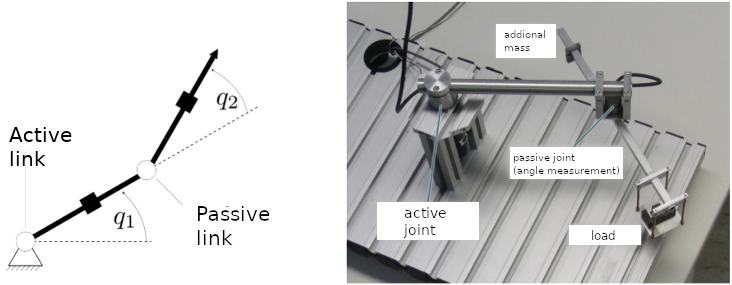Control of Underactuated Mechanical Systems
A mechanical system is called underactuated if the number of actuating inputs (applied forces or torques) is smaller than the number of mechanical degrees of freedom. If, on the other hand, the number of actuating interventions corresponds to the number of mechanical degrees of freedom, we speak of fully actuated systems. While the modeling of both system classes (underactuated or fully actuated) can be done in the same way with the common methods of rigid body mechanics (e.g. Newton, Euler-Langrange, Hamilton), underactuated systems are usually much more difficult to control than fully actuated systems. From a technical point of view, the transition to an underactuated system would correspond to the deliberate reduction of actuators and thus opens up an opportunity for material or cost savings. For special applications (e.g., in space technology), weight reduction could also be relevant. Likewise, it may be necessary to still be able to specifically influence certain systems in the event of an actuator defect.
Example: Planar Underactuated Manipulator

Publications
- Knoll, C.; Röbenack, K.: Maneuver Based Control of the 2-DOF Underactuated Manipulator in Normal Form Coordinates.
Systems Science & Control Engineering, vol. 3, no. 1, 2014, 26-38. - Knoll, C. & Röbenack, K.: Control of an underactuated manipulator using similarities to the double integrator.
Preprints of the 18th IFAC World Congress, 2011, 11501-11507. - Knoll, C.; Leist, B. & Röbenack, K.: Konzeption und prototypische Realisierung eines Versuchsstandes zur Regelung eines unteraktuierten Manipulators. In: Bertram, T.; Corves, B. & Janschek, K. (Hrsg.), Tagungsband Mechatronik 2011, 2011, 241-246.
- Knoll, C. & Röbenack, K.: Trajectory Planning for a Non Flat Mechanical System Using Time-Reversal Symmetry.
Proc. in Applied Mathematics and Mechanics, 2011, 11, 819–820 - Knoll, C. & Röbenack, K.: Sliding Mode Control of an Underactuated Two-Link Manipulator.
Proc. in Applied Mathematics and Mechanics, 2010, 10, 615-616. - Knoll, C. & Röbenack, K.: Analysis and Control of an Underactuated Pendulum.
Proc. 55. Internationales Wissenschaftliches Kolloquium, Ilmenau, 2010, 440-451